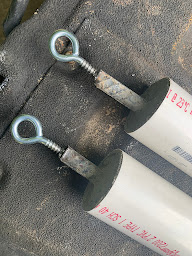Having run across a few round-tuits recently with a less intense work-travel schedule, tower and antenna maintenance is finally making its way onto the agenda. It's been neglected, and that really bugs me. Things have held up pretty well over the past decade (except for the tree mounted wire antennas, which I seem to get maybe 5 years of life before something breaks), but the Telrex tribander has suffered from metal fatigue on the big reflector, which made its way to earth unfortunately -- so a full inspection is needed.

SWR / directional wattmeters of various types are handy (I really prefer my Bird 43 for a simple, accurate, reliable meter) -- but they only give part of the picture about what's going on in your antenna system. For really granular tasks, nothing beats a Vector Network Analyzer to spell out the real and imaginary components of impedance, resonance points (which don't always correspond to low-SWR points), faults in feedlines, etc. A quick scan of my 7/8" Heliax and then the LMR-600 (which feeds the 30/17/12m antenna) revealed issues. The Andrews hardline looked great (thank goodness...it is way too expensive in today's copper market to contemplate a new run) -- but the LMR looked awful, with significant reflections appearing on the VNA TDR at different distances from the shack.

Turns out, that about 25' feet from the shack, the LMR-600 is exposed for a brief distance before it goes underground out to the tower. What did I find at the first fault? Teeth marks in the outer jacket... some critter had attempted to make a dinner out of my coax, and it looked like the jacket had been penetrated -- if ever so slightly. That section of coax needed to be replaced if there was any way to salvage the run. You can see (to the right) what the shield and dielectric looked like -- moisture had entered the coax and had slowly contaminated / oxidized the braid; normally both the foil and outer braid would be a nice, bright, shiny silver color. And here's the thing..the tiny holes allowed enough moisture to enter that it wicked in both directions from the damage about 4' -- so almost 8' of coax was ruined. No telling over what period of time this was allowed to happen -- but it was on the order of years. This contamination does nothing to DC -- but looks almost like a short to RF. Be warned.

The lesson here of course is to not put off maintenance; it really should be a routine part of running your station. Things will decay. Things will break. Mother nature will absolutely have her day. And putting off fixes only compounds the problems -- if I had caught this earlier, I could have saved a lot of time, effort, and $$ on the fix. And, good engineering can avoid problems.... in this case, limiting exposure to the coax (not laying it on the ground in a flower bed) would have prevented this.
Oh, just about forgot. The other fault found in the LMR was located at the base of the tower about 5' from the ground where the coax emerged from underground. The problem?
A pellet from an air rifle. Yep. Unlikely but true... it had penetrated the jacket in two places, and became lodged on the far side of the coax as it tried to exit. I'll see if I can find a picture and post it. Same result as the other fault, except for the water migration was primarily
down from the break in the jacket about 5 feet.
Given where these faults were located-- I'm likely going to just replace the entire run and salvage the remainder into a couple of 100' pieces which will get used on some future project.



















